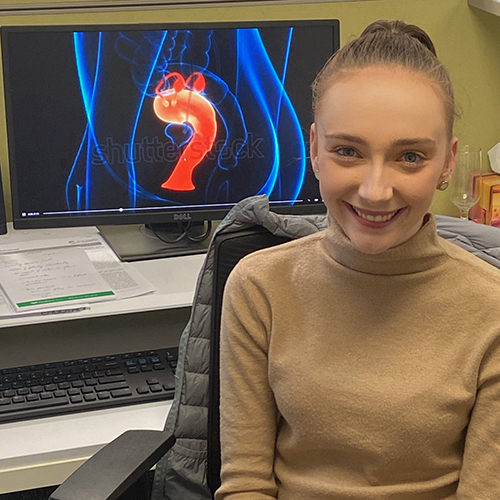07 September 2020
Jasmin Teurlings is one of 700,000 Australians who have endometriosis, a chronic, painful gynaecological condition that affects nearly three times as many women as breast cancer.
The 21-year-old UniSA journalism student has lived with the condition for five years after first experiencing symptoms at age 16, but it has taken invasive laparoscopic surgery for an official diagnosis.
Keyhole surgery is the standard option to reliably diagnose the three types of endometriosis (peritoneal, ovarian and deep infiltrating endometriosis), but comes with risks, delays, and sometimes a negative result.
“Undergoing an invasive procedure is stressful, even more so if it proves unnecessary” says UniSA researcher Alison Deslandes, who is exploring alternative diagnosis options for women with deep infiltrating endometriosis (DIE), the most severe and challenging type to manage.
“In recent years, transvaginal ultrasound (TVUS) has begun to play a role in the diagnosis of DIE and ovarian endometriosis, but it’s typically only offered by specialised gynaecologists,” Deslandes says.
The UniSA researcher is investigating the accuracy of TVUS and whether sonographers could perform the procedure in an outpatient facility, making it more accessible to women who are experiencing symptoms of endometriosis.
“In cases of DIE, extensive adhesions of the pelvic organs may not be discovered until the time of surgery, often requiring additional specialist surgeons. TVUS is a low cost and readily available imaging technique which could be used to identify more complex conditions, aiding surgery, as well as diagnosing the condition non-invasively.”
In a review of 35 articles, exploring the accuracy of TVUS for deep infiltrating endometriosis, Deslandes says it rates highly as a valuable, accurate diagnosis tool, apart from DIE detection in the bladder, which requires more data.
“We now need to take this a step further to see if sonographers could perform the same procedure as gynaecologists to the same level of accuracy. This would reduce diagnostic delays and give women with DIE a non-invasive yet highly accurate diagnostic test,” Deslandes says.
Endometriosis affects approximately 10 per cent of Australian women and occurs when tissue like that which lines the uterus (endometrial tissue) grows outside of the uterus, forming legions on the ovaries, bowel and pelvis – sometimes spreading to other organs.

It causes severe pain, typically with periods but also with sex, passing urine and bowel movements. It can also cause heavy or dysfunctional menstrual bleeding, a symptom that was the first red flag for Jasmin Teurlings while still in secondary school.
“My mother had previously been diagnosed with endometriosis so recognised the signs and was very quick to act,” Jasmin says. “Despite those symptoms and my family history, the first gynaecologist I saw said I was too young to have endometriosis.”
It took five more years for Jasmin to agree to laparoscopic surgery, convinced by medical specialists and even her own conflicting doubts that it was “all in her head”.
Diagnostic delays are common as the symptoms are often vague and medical professions are reluctant to subject women to surgery unless the signs persevere over a long period, Deslandes says.
“There is no cure for endometriosis so once a woman is diagnosed with it, she has it for life. If left untreated it can lead to fertility problems, and even renal failure in extreme cases.
“Surgery removes the deposits, although some hormone-based medications are prescribed to help stop the disease progressing and to reduce pain. For some women, one surgery will be all that is needed, and their pain will never return. Most women, however, require multiple surgeries and are never entirely free of pain,” Deslandes says.
Jasmin falls into the latter group.
“While the laparoscopy hasn’t cured my endometriosis, the diagnosis has gone a long way to reaffirming that the symptoms I have are real,” she says. “If an alternative diagnostic method can be found that doesn’t require invasive surgery, women will no longer have to wait years to be diagnosed and that would make a huge difference,” she says.
A video explaining the research can be viewed at: https://youtu.be/d0df5lgwSJU
Notes for Editors
“Current Status of Transvaginal Ultrasound Accuracy in the Diagnosis of Deep Infiltrating Endometriosis Before Surgery” is published in the American Institute of Ultrasound in Medicine. For a copy of the paper please email candy.gibson@unisa.edu.au
Other researchers involved in the project include Assoc Prof, Nayana Parange, Dr Jessie Childs and Brooke Osborne from UniSA’s medical sonography team.
……………………………………………………………………………………………………………
Media contact: Candy Gibson office +61 8 8302 0961 mobile: +61 434 605 142
email: candy.gibson@unisa.edu.au



